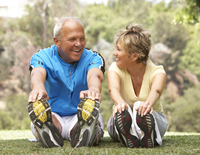By Julia Dennis
 When senior citizens go without sufficient exercise, they often lose motor skills, muscles power and their independence. The older you get, the more intimidating workouts may appear to be. However, since exercise science experts have been increasingly crafting fitness programs specifically for the senior population, older adults have no reason to fear fitness activity. Fitness and recreation centers are offering unique offerings, such as Zumba for seniors and martial arts programs uniquely tailored for senior fitness needs.
When senior citizens go without sufficient exercise, they often lose motor skills, muscles power and their independence. The older you get, the more intimidating workouts may appear to be. However, since exercise science experts have been increasingly crafting fitness programs specifically for the senior population, older adults have no reason to fear fitness activity. Fitness and recreation centers are offering unique offerings, such as Zumba for seniors and martial arts programs uniquely tailored for senior fitness needs.
Here are 10 fun options to keep people in their golden years healthy and in shape.
Pilates
A mind-body activity designed to increase flexibility and provide resistance training, Pilates can help seniors correct their posture, improve breathing and become stronger. Some seniors even report that they’ve gained a few inches in height by learning to lengthen their bodies and extend their skeletal frame while using a Pilates bench. While laying on the bench, seniors can push against the machine to strengthen legs, arms and core stomach muscles. Pilates is so low-impact and is safe enough to do four to five times a week.
Tai Chi
Using deep breathing and languid motion, Tai Chi can reportedly help seniors boost lung capacity, lower risk of Alzheimer’s disease and normalize blood pressure. It can also improve psychological mood, staving off depression. The ancient Chinese exercise uses visualization, meditation and body mechanics to harness and direct energy. Seniors can increase their balance and lower body strength.
Golfing
Using lightweight graphite clubs, senior citizens with limited power and range of motion can still enjoy a day on the green. A once-a-week golf date may help seniors burn a significant number of calories (over 700 for a typical 9-hole course) and fight heart disease.
Bicycling
Bicycling can strengthen knees, increase leg strength and improve the heart rate for seniors. While some seniors do indeed cycle outdoors, the best option is to use a level indoor track or a stationary bicycle. Seniors who’ve been active for years can cycle 30 minutes a day. Those who are newly active should aim for 10 minutes on a stationary bike three days a week. If pedaling forward is too overwhelming, experts recommend that novice seniors began with backward cycling.
Swimming
Seniors can hit the pool or the ocean to explore the health benefits of swimming. In addition to strengthening the heart, swimming can help seniors improve their breathing and recover or retain lean leg and arm muscles. To avoid overexertion, seniors should limit themselves to simple strokes, such as the breaststroke, and swim slowly for no more than 30 minutes a session. This can be done two or three times a week.
Zumba for Seniors
Featuring dance-based aerobics set to Latin merengue or salsa music, Zumba is often taught at a slowed-down pace for seniors, catering to growing masses of grandmas and grandpas who want to sway hips and move to a sensual dance beat. While the physical movements boosts the heart rate, remembering the steps and routines helps with memory, doctors say. Try this on weekends, either at a fitness gym or a supper club with a dance floor.
Yoga
Yoga is beneficial for senior psyches and bodies due to its focus on stress-relieving postures and movements, such as the Corpse Pose, which is the ultimate in relaxation and involves lying supine on the floor. Other poses involve standing on one leg for balance and stretching outward pr skyward in order to improve agility. Yoga can be enjoyed by seniors three to five times weekly.
Walking
 Seniors can gain a multitude of benefits from sauntering around the block or shopping center two to three times a week for 45 minutes per walking session. Studies show that walking can help older people keep their mobility, fight diabetes, reduce blood pressure and fight osteoporosis by fortifying bones.
Seniors can gain a multitude of benefits from sauntering around the block or shopping center two to three times a week for 45 minutes per walking session. Studies show that walking can help older people keep their mobility, fight diabetes, reduce blood pressure and fight osteoporosis by fortifying bones.
Strength Training
In addition to aerobic activity, seniors also need to strengthen muscles so that they can continue to open doors, carry groceries, do household chores and maintain their ability to be free and independent.. The typical way to build strength is to use resistance bands, resistance machines with adjustable levels of difficulty or free weights, ranging from five to 10 pounds. Doctors recommend that older individuals limit strength training to just twice a week.
Water Aerobics
For seniors with hypertension and bad joints, doing aerobics in the water is a calming experience that relieves pain and lowers the potential for exercise-related blood pressure spikes. Seniors develop better balancing skills and the water-based resistance encourages lean muscle development. Start out by using water shoes to slowly saunter around the perimeter of the pool. Then, amp up the workout by doing arm lifts and downward pushes. Underwater squats and lungs can work out the legs.
– Julia Dennis writes about Eco Friendly assisted living communities and other assisted living topics for Friendship Village. When she’s not writing she enjoys running and spending time with her children
